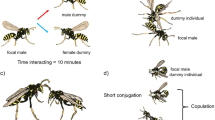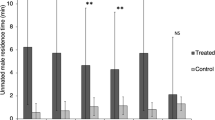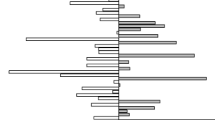Abstract
Pheromones may convey information about mate quality and social status. In the field cricket Gryllus integer, females mount the males for copulation, such that males cannot coerce females to mate. We examined whether virgin G. integer females preferred the scent of potentially dominant males to that of subordinate males. First, we collected pheromones by confining males on filter paper. Next, we offered filter paper from each of two size-matched males and control paper to females that had never been exposed to males, and measured the time spent by the female on each kind of paper. Finally, dominance status of the males in each size-matched pair was determined by pitting the two males against one another in agonistic contests. When offered filter paper from subsequently dominant versus subsequently subordinate males, females spent more time on the paper from the dominant male than the subordinate male, and much less time on control paper. Thus, pheromones may inform female G. integer about a male's potential to achieve dominant social status. Male pheromones were also associated with the female's tendency to mount a male. In contrast to cockroaches, where females prefer the scent of subordinate males (presumably to avoid risk of injury), female crickets prefer the scent of potentially dominant males and are more likely than males to wound their mating partners.


Similar content being viewed by others
References
Adamo SA, Hoy RR (1995) Agonistic behavior in male and female field crickets, Gryllus bimaculatus, and how behavioral context influences its expression. Anim Behav 49:1491–1501
Adamo SA, Schildberger K, Loher W (1994) The role of the corpora allata in the adult male cricket (Gryllus campestris and Gryllus bimaculatus) in the development and expression of its agonistic behavior. J Insect Physiol 40:439–446
Alatalo RV, Höglund J, Lundberg A (1991) Lekking in the black grouse – a test of male viability. Nature 352:155–156
Alexander RD (1961) Aggressiveness, territoriality and sexual behavior in field crickets (Orthoptera: Gryllidae). Behaviour 17:130–223
Andersson MB (1994) Sexual selection. Princeton University Press, Princeton
Arnold SJ, Houck LD (1982) Courtship pheromones: evolution by natural and sexual selection. In: Nitecki M (ed) Biochemical aspect of evolutionary biology. Chicago University Press, Chicago, pp 173–211
Berglund A, Bisazza A, Pilastro A (1996) Armaments and ornaments: an evolutionary explanation of traits of dual utility. Biol J Linnean Soc 58:385–399
Birch MC, Haynes KF (1982) Insect pheromones. Edward Arnold, London
Candolin U (1999) Male–male competition facilitates female choice in sticklebacks. Proc Roy Soc Lond B 266:785–789
Chapman T, Arnqvist G, Bangham J, Rowe L (2003) Sexual conflict. Trends Ecol Evol 18:41–47
Cox CR, LeBoeuf BJ (1977) Female incitation of male competition: a mechanism in sexual selection. Am Nat 111:317–335
Grafen A (1990) Biological signals as handicaps. J Theor Biol 144:517–546
Gray DA, Cade WH (1999) Quantitative genetics of sexual selection in the field cricket, Gryllus integer. Evolution 53:848–854
Gullan PJ, Cranston PS (2000) The insects. An outline of entomology second edition. Blackwell Science, London
Haley MP (1994) Resource-holding power asymmetries, the prior residence effect, and reproductive payoffs in male northern elephant seal fights. Behav Ecol Sociobiol 34:427–434
Hartfelder K (2000) Insect juvenile hormone: from “status quo” to high society Braz J Med Biol Res 33:157–177
Hedrick AV (1986) Female preferences for male calling bout duration in a field cricket. Behav Ecol Sociobiol 19:73–77
Hedrick AV, Weber T (1998) Variance in female responses to the fine structure of male song in the field cricket, Gryllus integer. Behav Ecol 9:582–591
Hillgarth N, Wingfield JC (1997) Parasite-mediated sexual selection: endocrine aspects. In: Clayton D, Moore E (eds) Host–parasite evolution: general principles and avian models. Oxford University Press, Oxford, pp 78–104
Hofmann HA, Schildberger K (2001) Assessment of strength and willingness to fight during aggressive encounters in crickets. Anim Behav 62:337–348
Loher W, Dambach M (1989) Reproductive behaviour. In Huber F, Moore TE, Loher W (eds) Cricket behavior and neurobiology. Cornell University Press, Ithaca, pp 43–82
Karlson P, Lüscher M (1959) “Pheromones” a new term for a class of biologically active substances. Nature 183:55–56
Kokko H (2005) Treat ‘em mean, keep ‘em (sometimes) keen: Evolution of female preferences for dominant and coercive male. Evol Ecol (in press)
Kortet R, Hedrick A (2004) Detection of the spider predator, Hololena nedra by naïve juvenile field crickets (Gryllus integer) using indirect cues. Behaviour 141:1189–1196
Kortet R, Taskinen J, Vainikka A, Ylönen H (2004) Breeding tubercles, papillomatosis and dominance behaviour of male roach (Rutilus rutilus) during the spawning period. Ethology 110:591–602
Matsumoto Y, Mizunami M (2000) Olfactory learning in the cricket Gryllus bimaculatus. J Exp Biol 203:2581–2588
Matsumoto Y, Mizunami M (2002) Temporal determinants of olfactory long-term retention in the cricket Gryllus bimaculatus. J Exp Biol 205:1429–1437
Moore AJ, Gowaty PA, Wallin WG, Moore PJ (2001) Sexual conflict and the evolution of female mate choice and male social dominance. Proc Roy Soc Lond B 268:517–523
Moore AJ, Gowaty PA, Moore PJ (2003) Females avoid manipulative males and live longer. J Evol Biol 16:523–530
Otte D, Cade W (1976) On the role of olfaction in sexual and interspecies recognition in crickets (Acheta and Gryllus). Anim Behav 24:1–6
Qvarnstrom A, Forsgren E (1998) Should females prefer dominant males? Trends Ecol Evol 13:498–501
Penn D, Potts W (1998) Chemical signals and parasite-mediated sexual selection. Trends Ecol Evol 13:391–396
Rantala MJ, Kortet R (2003) Courtship song and immune function in the field cricket Gryllys bimaculatus. Biol J Linnean Soc 79:503–510
Rantala MJ, Kortet R (2004) Male dominance and immunocompetence in the field cricket (Gryllus bimaculatus). Behav Ecol 15:187–191
Rantala MJ, Jokinen I, Kortet R, Vainikka A, Suhonen J (2002) Do pheromones reveal male immunocompetence? Proc Roy Soc Lond B 269:1681–1685
Rantala MJ, Kortet R, Kotiaho JS, Vainikka A, Suhonen J (2003a) Condition dependence of pheromones and immune function in the grain beetle Tenebrio molitor. Funct Ecol 17:534–540
Rantala MJ, Kortet R, Vainikka A (2003b) The role of juvenile hormone in immune function and pheromone production trade-offs: a test of the immunocompetence handicap principle. Proc Roy Soc Lond B 270:2257–2261
Rekwot PI, Ogwu D, Oyedipe EO, Sekoni VO (2001) The role of pheromones and biostimulation in animal reproduction. Anim Reprod Sci 65:157–170
Savage KE, Hunt J, Jennions MD, Brooks R (2005) Male attractiveness covaries with fighting ability but not with prior fight outcome in house crickets. Behav Ecol 16: 196–200
Simmons LW (1986a) Inter-male competition and mating success in the field cricket, Gryllus bimaculatus (De Geer). Anim Behav 34:567–579
Simmons LW (1986b) Female choice in the field cricket, Gryllys bimaculatus (D Geer). Anim Behav 34:1463–1470
Simmons LW (1990) Pheromonal cues for the recognition of kin by female field crickets, Gryllus bimaculatus. Anim Behav 40:192–195
Sreng L, Leoncini I, Clement JL (1999) Regulation of sex pheromone production in the male Nauphoeta cinerea cockroach: role of brain extracts, corpora allata (CA), and juvenile hormone (JH). Arch Insect Biochem 40:165–172
Teal PEA, Gomez-Simuta Y, Proveaux AT (2000) Mating experience and juvenile hormone enhance sexual signaling and mating in male Caribbean fruit flies. Proc Natl Acad Sci USA 97:3708–3712
Wagner Jr. WE, Reiser MG (2000). The relative importance of calling song and courtship song in female mate choice in the variable field cricket. Anim Behav 59:1219–1226
Wyatt TD (2003) Pheromones and animal behaviour. University Press, Cambridge
Tregenza T, Wedell N (1997) Definitive evidence for cuticular pheromones in a cricket. Anim Behav 54:979–984
Wedell N, Tregenza T (1999) Successful fathers sire successful sons. Evolution 53:620–625
Zahavi A (1975) Mate selection – a selection for a handicap. J Theor Biol 53:205–214
Acknowledgements
Special thanks to M. Tam, R. Helkala, L. Berger and A. Leonard for their assistance in the laboratory. We thank A. Vainikka, H. Kokko and four anonymous reviewers for helpful comments on the manuscript. This study was supported by the Academy of Finland to RK (decision 204837) and by a grant from the National Science Foundation to AH (NSF IBN-0076484). The experiments reported here comply with the current laws of the USA
Author information
Authors and Affiliations
Corresponding author
Additional information
Communicated by M. Siva-Jothy
Rights and permissions
About this article
Cite this article
Kortet, R., Hedrick, A. The scent of dominance: female field crickets use odour to predict the outcome of male competition. Behav Ecol Sociobiol 59, 77–83 (2005). https://doi.org/10.1007/s00265-005-0011-1
Received:
Revised:
Accepted:
Published:
Issue Date:
DOI: https://doi.org/10.1007/s00265-005-0011-1




